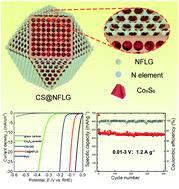当前位置:
X-MOL 学术
›
Sustain. Energy Fuels
›
论文详情
Our official English website, www.x-mol.net, welcomes your
feedback! (Note: you will need to create a separate account there.)
Boosting the electrocatalytic hydrogen evolution and sodium-storage properties of Co9S8 nanoparticles via encapsulation with nitrogen-doped few-layer graphene networks
Sustainable Energy & Fuels ( IF 5.0 ) Pub Date : 2021-08-04 , DOI: 10.1039/d1se00829c Lizhi Qian 1 , Zhiqiang Wei 1 , Tingli Yu 1 , Bingdong Chang 2 , Zhiyuan Wang 1, 3, 4 , Yanguo Liu 1, 3, 4 , Hongyu Sun 3 , Wei Huang 5
Sustainable Energy & Fuels ( IF 5.0 ) Pub Date : 2021-08-04 , DOI: 10.1039/d1se00829c Lizhi Qian 1 , Zhiqiang Wei 1 , Tingli Yu 1 , Bingdong Chang 2 , Zhiyuan Wang 1, 3, 4 , Yanguo Liu 1, 3, 4 , Hongyu Sun 3 , Wei Huang 5
Affiliation

|
Cobalt sulfides have attracted much attention as multifunctional electrocatalysts to trigger important reactions, for example, hydrogen evolution, oxygen evolution, and oxygen reduction reactions, and as electrodes for lithium or sodium ion storage. Nevertheless, the delivery of cobalt sulfide structures with high performance with long-term stability is still a challenge. In the current work reported here, via employing a metal–organic framework (MOF) as the starting material, a simple oxygen-assisted etching strategy to synthesize Co9S8 nanoparticles coated with N-doped few-layer graphene (CS@NFLG) was developed. Microstructure studies show that the graphene layer is doped with the nitrogen element and forms a continuous three-dimensional (3D) conductive network, which protects the inner Co9S8 nanoparticles in the harsh reaction environment and modulates the electronic interactions with the Co9S8 particle surface. Because of the advantages of the unique microstructure, CS@NFLG possesses excellent HER activity in an acidic medium (0.5 M H2SO4) at a low onset overpotential of 50 mV with a small Tafel slope of 73 mV dec−1. Meanwhile, the sample presents remarkable sodium storage properties in terms of a high reversible capacity, good rate capabilities, and good stability. In particular, the CS@NFLG electrode delivers a specific capacity of 505 mA h g−1 after 100 cycles at 0.5 A g−1. Moreover, the CS@NFLG electrode still maintains a high specific capacity of 442.3 mA h g−1 after 400 cycles at a high current density of 1.2 A g−1. This work shows that nanoscale “top-down” etching from the bottom is a promising route for the fine modulation of the structure and composition at the electronic and atomic scales, thus showing great prospects for use in energy storage and conversion applications.
中文翻译:

通过用氮掺杂的几层石墨烯网络封装来提高 Co9S8 纳米粒子的电催化析氢和储钠性能
硫化钴作为多功能电催化剂引发了重要的反应,例如析氢、析氧和氧还原反应,以及作为锂或钠离子存储的电极而备受关注。然而,提供具有长期稳定性的高性能硫化钴结构仍然是一个挑战。在这里报道的当前工作中,通过采用金属有机骨架 (MOF) 作为起始材料,一种简单的氧辅助蚀刻策略来合成 Co 9 S 8开发了涂有 N 掺杂的少层石墨烯 (CS@NFLG) 的纳米颗粒。微观结构研究表明,石墨烯层掺杂氮元素并形成连续的三维 (3D) 导电网络,在恶劣的反应环境中保护内部的 Co 9 S 8纳米粒子并调节与 Co 9 S的电子相互作用8颗粒表面。由于独特的微观结构的优势,CS@NFLG 在酸性介质(0.5 MH 2 SO 4)中以 50 mV 的低起始过电位和 73 mV dec -1的小 Tafel 斜率具有优异的 HER 活性. 同时,该样品在高可逆容量、良好的倍率能力和良好的稳定性方面表现出显着的储钠性能。特别是,CS@NFLG 电极在 0.5 A g -1 下循环 100 次后可提供 505 mA hg -1的比容量。此外,CS@NFLG 电极在1.2 A g -1的高电流密度下循环400 次后仍保持442.3 mA hg -1的高比容量。这项工作表明,从底部进行纳米级“自上而下”蚀刻是在电子和原子尺度上对结构和成分进行精细调制的一条有前途的途径,因此在能量存储和转换应用中具有广阔的应用前景。
更新日期:2021-08-19
中文翻译:

通过用氮掺杂的几层石墨烯网络封装来提高 Co9S8 纳米粒子的电催化析氢和储钠性能
硫化钴作为多功能电催化剂引发了重要的反应,例如析氢、析氧和氧还原反应,以及作为锂或钠离子存储的电极而备受关注。然而,提供具有长期稳定性的高性能硫化钴结构仍然是一个挑战。在这里报道的当前工作中,通过采用金属有机骨架 (MOF) 作为起始材料,一种简单的氧辅助蚀刻策略来合成 Co 9 S 8开发了涂有 N 掺杂的少层石墨烯 (CS@NFLG) 的纳米颗粒。微观结构研究表明,石墨烯层掺杂氮元素并形成连续的三维 (3D) 导电网络,在恶劣的反应环境中保护内部的 Co 9 S 8纳米粒子并调节与 Co 9 S的电子相互作用8颗粒表面。由于独特的微观结构的优势,CS@NFLG 在酸性介质(0.5 MH 2 SO 4)中以 50 mV 的低起始过电位和 73 mV dec -1的小 Tafel 斜率具有优异的 HER 活性. 同时,该样品在高可逆容量、良好的倍率能力和良好的稳定性方面表现出显着的储钠性能。特别是,CS@NFLG 电极在 0.5 A g -1 下循环 100 次后可提供 505 mA hg -1的比容量。此外,CS@NFLG 电极在1.2 A g -1的高电流密度下循环400 次后仍保持442.3 mA hg -1的高比容量。这项工作表明,从底部进行纳米级“自上而下”蚀刻是在电子和原子尺度上对结构和成分进行精细调制的一条有前途的途径,因此在能量存储和转换应用中具有广阔的应用前景。











































 京公网安备 11010802027423号
京公网安备 11010802027423号